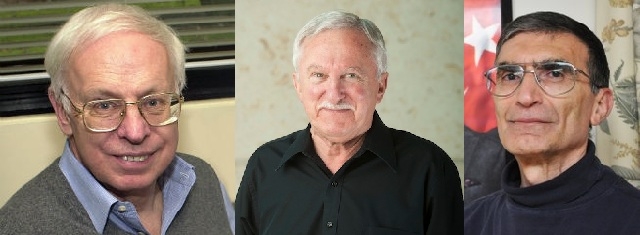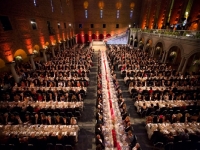Technology
NOBEL PRIZE IN CHEMISTRY AWARDED FOR RESEARCH INTO HOW DNA REPAIRS ITSELF
TOMAS LINDAHL, PAUL MODRICH, AZIZ SANCAR

The Nobel Prize in Chemistry 2015 (Source: Crick - Biochem - Med)
USPA NEWS -
The Nobel Prize in Chemistry 2015 is awarded to Tomas Lindahl, Paul Modrich and Aziz Sancar for having mapped, at a molecular level, how cells repair damaged DNA and safeguard the genetic information...
The Nobel Prize in Chemistry 2015 is awarded to Tomas Lindahl, Paul Modrich and Aziz Sancar for having mapped, at a molecular level, how cells repair damaged DNA and safeguard the genetic information. Their work has provided fundamental knowledge of how a living cell functions and is, for instance, used for the development of new cancer treatments.
The reason our genetic material does not disintegrate into complete chemical chaos is that a host of molecular systems continuously monitor and repair DNA. The Nobel Prize in Chemistry 2015 awards three pioneering scientists who have mapped how several of these repair systems function at a detailed molecular level.
The reason our genetic material does not disintegrate into complete chemical chaos is that a host of molecular systems continuously monitor and repair DNA. The Nobel Prize in Chemistry 2015 awards three pioneering scientists who have mapped how several of these repair systems function at a detailed molecular level.
AZIZ SANCAR has mapped nucleotide excision repair, the mechanism that cells use to repair UV damage to DNA. People born with defects in this repair system will develop skin cancer if they are exposed to sunlight. The cell also utilises nucleotide excision repair to correct defects caused by mutagenic substances, among other things.
PAUL MODRICH has demonstrated how the cell corrects errors that occur when DNA is replicated during cell division. This mechanism, mismatch repair, reduces the error frequency during DNA replication by about a thousandfold. Congenital defects in mismatch repair are known, for example, to cause a hereditary variant of colon cancer.
PAUL MODRICH has demonstrated how the cell corrects errors that occur when DNA is replicated during cell division. This mechanism, mismatch repair, reduces the error frequency during DNA replication by about a thousandfold. Congenital defects in mismatch repair are known, for example, to cause a hereditary variant of colon cancer.
In the early 1970s, scientists believed that DNA was an extremely stable molecule, but TOMAS LINDAHL demonstrated that DNA decays at a rate that ought to have made the development of life on Earth impossible. This insight led him to discover a molecular machinery, base excision repair, which constantly counteracts the collapse of our DNA.
Tomas Lindahl
Francis Crick Institute and Clare Hall Laboratory, Hertfordshire, UK
Paul Modrich
Howard Hughes Medical Institute and Duke University School of Medicine, Durham, NC, USA
Aziz Sancar
University of North Carolina, Chapel Hill, NC, USA
Source : The Nobel Prize
Tomas Lindahl
Francis Crick Institute and Clare Hall Laboratory, Hertfordshire, UK
Paul Modrich
Howard Hughes Medical Institute and Duke University School of Medicine, Durham, NC, USA
Aziz Sancar
University of North Carolina, Chapel Hill, NC, USA
Source : The Nobel Prize
Ruby Bird Yasmina Beddou Nobel Prize 2015 Chemistry Dna Repairs Tomas Lindahl Paul Modrich Aziz Sancar Cancer Treatment Discovery Research Royal Swedish Academy Of Sciences
Liability for this article lies with the author, who also holds the copyright. Editorial content from USPA may be quoted on other websites as long as the quote comprises no more than 5% of the entire text, is marked as such and the source is named (via hyperlink).






